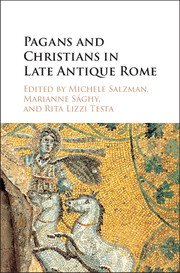 Pagans and Christians in Late Antique Rome
Pagans and Christians in Late Antique Rome Book contents
- Frontmatter
- Contents
- List of Illustrations
- Biographies of Authors
- Acknowledgments
- Introduction
- Part I SENATORIAL POLITICS AND RELIGIOUS CONFLICT
- Part II The Construction of New Religious Identities
- Part III Pagans and Christians: Coexistence and Competition
- Section A Pagans and Religious Practices in Christian Rome
- Section B Death and the Afterlife
- Section C Reading Religious Iconography as Evidence for Pagan–Christian Relations
- 16 Rome and Imagery in Late Antiquity: Perception and Use of Statues
- 17 What to Do with Sacra Antiqua? A Reinterpretation of the Sculptures from S. Martino ai Monti in Rome
- 18 Myth and Salvation in the Fourth Century: Representations of Hercules in Christian Contexts
- Concluding Remarks: Vrbs Roma between Pagans and Christians
- Index
- References
16 - Rome and Imagery in Late Antiquity: Perception and Use of Statues
from Section C - Reading Religious Iconography as Evidence for Pagan–Christian Relations
Published online by Cambridge University Press: 05 November 2015
- Frontmatter
- Contents
- List of Illustrations
- Biographies of Authors
- Acknowledgments
- Introduction
- Part I SENATORIAL POLITICS AND RELIGIOUS CONFLICT
- Part II The Construction of New Religious Identities
- Part III Pagans and Christians: Coexistence and Competition
- Section A Pagans and Religious Practices in Christian Rome
- Section B Death and the Afterlife
- Section C Reading Religious Iconography as Evidence for Pagan–Christian Relations
- 16 Rome and Imagery in Late Antiquity: Perception and Use of Statues
- 17 What to Do with Sacra Antiqua? A Reinterpretation of the Sculptures from S. Martino ai Monti in Rome
- 18 Myth and Salvation in the Fourth Century: Representations of Hercules in Christian Contexts
- Concluding Remarks: Vrbs Roma between Pagans and Christians
- Index
- References
Summary
Divine statues, as objects that were thought of very differently in terms of both their nature and their use, crystallized the tensions between pagans and Christians in the fourth and fifth centuries. The “graven image” as an emblem of pagan religions gradually became the preferred target of Christians. From the second half of the second century, ideas on the link between the god and its effigy, on the type of representation based on mimicry as well as on its actual power were put forward by both Christian authors and pagan philosophers, who reflected on their conception of piety and on the religious relationship between mankind and the divine. Some of the arguments Christian writers advanced on divine statues in fact came to be used as encouragement and justification for legal decisions that limited and then prohibited their use, occasionally with a concern for protecting the work nonetheless, but little is known about the efficacy of these measures or the precise nature of the objects involved. We do not know whether all kinds of divine effigy were affected, or if these attacks targeted only consecrated images. In any case, these struggles over the approach to divine statues gradually modified the role they played in the city. As Lepelley has shown, divine statues lost their primary purpose and became real “heritage” objects. In Rome, a fairly wide range of sources, comprising inscriptions, writings by Christian or pagan authors, and archeological and iconographical data, allows us to follow the main phases of this change of status. Statues became markers of a society in transition, and they allow us to observe their complex relationship with tradition and the past in the context of the diffusion of a new culture that weakened and called into question some of the structures underpinning society, in Rome more so than elsewhere.
I:Tradition and Initial Tensions Surrounding Images
In the fourth century, Christian reticence toward divine representations was above all evident in literature, with only rare material consequences, since the tradition of erecting images to the gods in fact remained a powerful one. Effigies were still very current, to the extent that from 331 a civil servant with responsibility for statues in the city of Rome was appointed, the curator statuarum.
- Type
- Chapter
- Information
- Pagans and Christians in Late Antique RomeConflict, Competition, and Coexistence in the Fourth Century, pp. 345 - 359Publisher: Cambridge University PressPrint publication year: 2015


